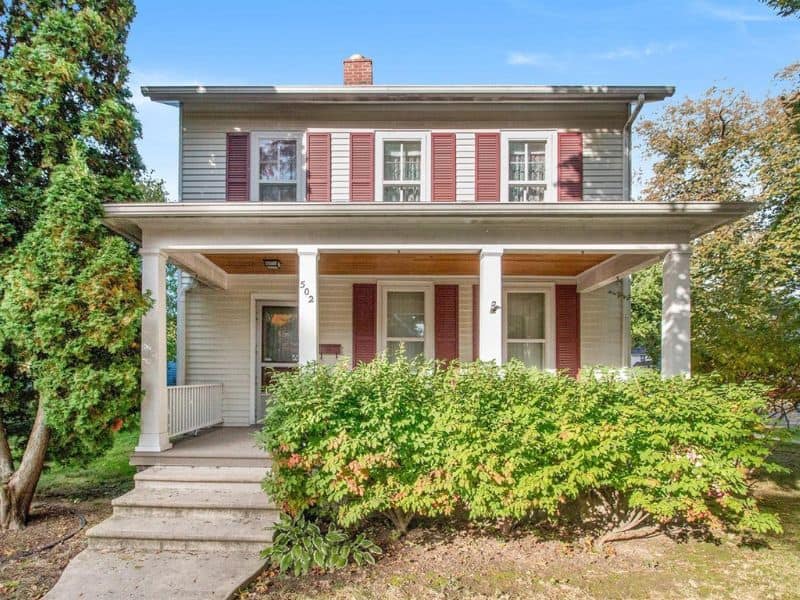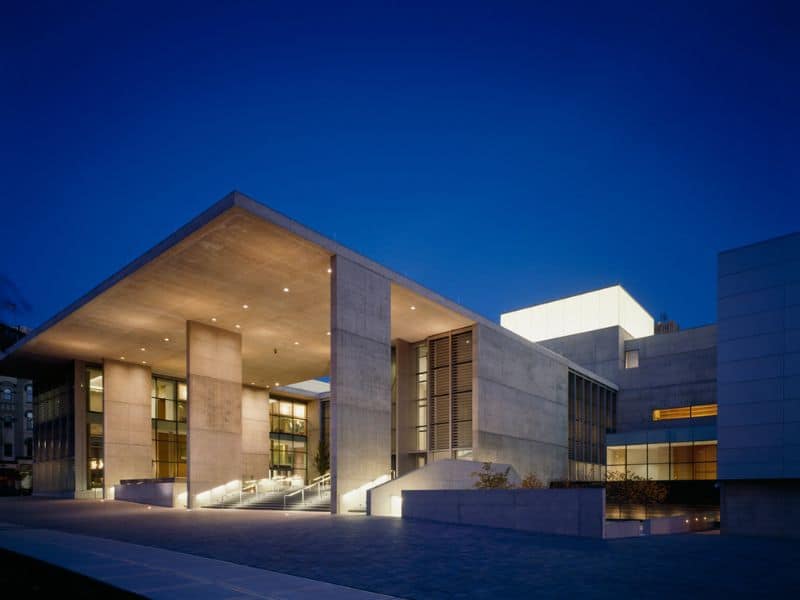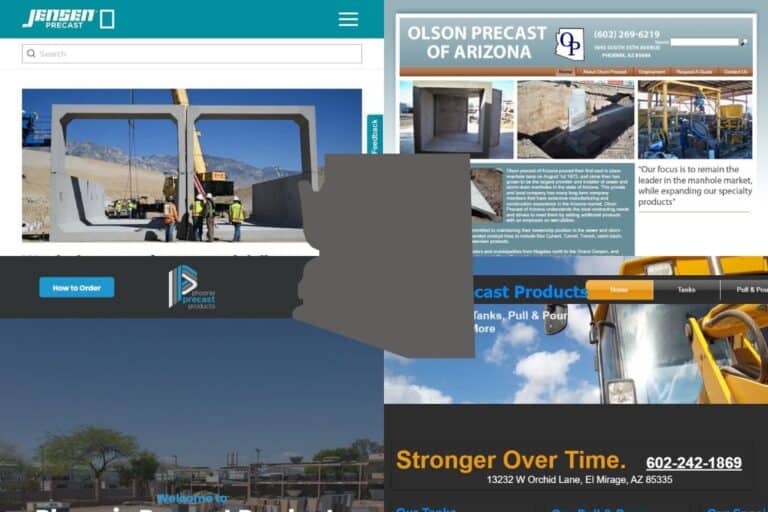The Top 15 Eco-Friendly Sustainable Buildings in Michigan

Images courtesy of REjournals.com, The Regents of the University of Michigan, Ann Arbor Area Board of REALTORS®, and The Regents of the University of Michigan.
Besides the diverse array of natural landscapes, fresh water, and forested areas, Michigan residents and builders are taking strides to improve the environment and address climate change through sustainable buildings.
From passive solar design principles to green roofs, there is an array of eco-friendly, sustainable buildings in Michigan to inspire your next project.
According to a study by the World Economic Forum, eco-friendly buildings can reduce temperatures, especially in cities, by up to 2℃ (3.6°F).
Consequently, they play a critical role in the fight against global warming and climate change. This explains why shifting to green buildings contributes toward making the world a better place.
In this article, I’ve rounded up a list of the top 15 eco-friendly sustainable buildings in Michigan. From skyscrapers and offices to governmental and institutional buildings, read on to learn more about these inspiring green structures.
1. Cunningham-Limp Project

Located in Farmington Hills, the Cunningham-Limp project has some of the most eco-friendly sustainable buildings in Michigan due to its array of green initiatives.
The six-building project sits on a 10-acre (4.05-hectare) plot and is the U.S.-based headquarters for Japan Solderless Terminals, an electrical-connection maker.
The project’s first sustainability feature is that it incorporates all-natural materials with minimum environmental impact. It doesn’t use structured steel, paint, drywall, storm pipes, catch basins, or other synthetic materials that affect the environment.
Moreover, all materials were sourced within a 500-mile (805-km) radius of the project to reduce energy costs and environmental impacts of transportation, like emissions.
Other green building features integrated into the Cunningham-Limp Project include:
- Thatched green roofs: These are essential in energy conservation since they form an insulation layer on the roof. Therefore, they minimize passive heat gain in summer and heat loss in winter.
- Wetland protection: The construction crew preserved the natural wetland on-site and incorporated it into the project’s overall design.
- Geothermal wells: The project has 72 geothermal wells installed 450 feet (137 meters) below the ground for temperature regulation through energy-efficient technology.
- Afforestation: Replanting trees cleared to create space for the project.
2. Jeff T. Blau Hall

Jeff T. Blau Hall is among the most sustainable structures owned by Michigan University.
The 104,000-square-foot (9,662-square-meter) structure houses classrooms, administrative offices, and group study spaces.
The building was awarded LEED Gold certification in 2017 for its many green features.
During its renovation for eco-friendliness, 75% of construction and demolition waste was diverted from landfills. Diverting waste from landfills is essential in reducing environmental pollution.
Moreover, the building has features that help save up to 41% of water, in line with the Energy Policy Act of 1992. Such features include low-flow fixtures, rainwater harvesting, and efficient irrigation.
Jeff T. Blau Hall is code-compliant. Consequently, it saves up to 30% of energy through its energy-efficient windows and advanced lighting systems that incorporate LED fixtures.
The hall’s location in a densely-populated urban area within walking distance of basic amenities like restaurants, retail stores, and banks is also an excellent sustainability feature. It reduces car ownership and carbon emissions from vehicles — a primary contributor to global warming.
3. 502 Second Street

502 Second Street is a 100+-year-old double-LEED Platinum building in Michigan.
It was originally built in 1917 but renovated in 2014 with more eco-friendly features. The renovation integrated sustainable building materials to minimize the structure’s environmental impact.
Catalyst Partners, the company tasked with the renovation work, won the Outstanding Green Building Award in 2019 from the U.S. Green Building Council. This was after the exemplary work it did to make the building sustainable.
502 Second Street was renovated with energy-efficient amenities like fixtures to conserve energy. As a result, it uses 60% less energy than most office buildings in Michigan.
Moreover, it has efficient low-flow fixtures to conserve water. These fixtures have made it possible to use 45% less water than the set threshold.
The building’s landscaping adheres to permaculture principles.
The permaculture design integrates native and region-adaptive plants to reduce the need for fertilization and irrigation. Therefore, it helps conserve water while protecting the ecosystem from toxic fertilizer chemicals.
Finally, the building’s nearby garden was reclaimed into farming land to enhance sustainable cultivation. It produces food for the residents and the surrounding community.
4. The Ross Building

The Ross Building is a University of Michigan project that focuses on sustainability.
Opened in 2009, the building incorporates sustainable construction techniques to showcase the university’s focus on green building. As a result, it earned a LEED Silver certification for its eco-friendly architectural innovation.
The Ross Building has the following sustainable features:
- An efficient lighting system that integrates daylight-dimming to lower energy consumption. The move helps save 25% of energy.
- It uses displacement ventilation with less reliance on heating, cooling, and fans.
- It has large skylights that maximize daylighting, lowering the need for artificial lighting.
- It has occupancy sensors and motion-activated light switches to further lower energy consumption.
- Its two green roofs aid in stormwater management by filtering rainwater. They also reduce the heat island effect.
- Its low-flow plumbing fixtures reduce water consumption by 42%.
- It integrates renewable materials like cork flooring.
- 75% of the project’s construction and demolition waste was recycled.
- Drought-resistant and native plants were used in landscaping to reduce water consumption through irrigation.
- It integrates materials with low chemical emittance for carpeting and painting.
5. Herman Miller Greenhouse

Located in Holland, Herman Miller Greenhouse is one of the most eco-friendly sustainable buildings in Michigan.
William McDonough, a New York-based architect, designed this 295,000-square-foot (27,400-square-meter) building to be highly sustainable.
The building has 66 skylights for natural lighting that covers an extensive floor area. Natural lighting conserves a significant amount of energy by lowering artificial lighting demand.
Moreover, Herman Miller Greenhouse has an efficient stormwater management system with rainwater harvesting structures and filters. The harvested water is used for irrigation and other landscaping activities, reducing the need for drawing from public or other sources.
Its air-filtering systems have also made it possible to maintain high air quality standards. The systems protect occupants and the environment by reducing the amount of chemicals in the workplace air.
What sets this building apart is that its skylight integration sets the standard for the U.S. Green Building Council’s LEED Certification.
The above eco-friendly features made it possible for Herman Miller to double their productivity and recover finances within five years.
6. Kresge Hall

Owned by the University of Michigan’s Stephen M. Ross School of Business, Kresge Hall demonstrates a clear commitment to sustainability.
The project aimed to create an example for other campus buildings to follow. As such, it features many green building features, including:
- Stormwater management: It has an effective stormwater retention basin that reduces 86% of site runoff. It also has a Continuous Deflective Separation (CDS) system to filter debris and sediments.
- Transit access: It’s within walking distance to bus stops and U-M commuters to encourage the use of public transportation and minimize carbon emissions.
- Water efficiency: It has a real-time water flow monitoring system to detect any leakages for immediate repairs. Moreover, it has low-flow sinks, toilets, and urinals that help reduce water consumption by 41%.
- Energy conservation: It has efficient lighting fixtures that integrate task lighting to lower energy consumption. The hall also incorporates natural daylighting and occupancy sensors for lights and HVAC systems.
- Green roof: The project integrates a green roof that helps protect the building from extreme temperatures while providing additional insulation. The roof has an extensive plantation with regional vegetation for effective water conservation.
7. Mary Idema Pew Library

Based in Allendale, Mary Idema Pew Library is owned and operated by Grand Valley State University.
The 150,300-square-foot (13,960-square-meter) library opened in 2013 and is one of the university’s most eco-friendly buildings.
As the first LEED Platinum-certified library in Michigan, Mary Idema Pew Library features many sustainability elements, including:
- Natural daylighting: It has an impressive skylight system that maximizes natural daylighting and reduces electricity consumption for lighting. This feature contributed immensely toward the award of LEED Platinum certification to the library by supplying 75% of the library’s daylighting needs.
- Energy efficiency: The building has occupancy sensors that detect movement and switch the lights on or off accordingly. Furthermore, it has active window shades and passive solar shading that help reduce the need for air cooling.
- Efficient HVAC system: The library’s HVAC system has underfloor air distribution systems, demand-controlled ventilation, and insulating wrapping around heat pipes to conserve energy.
- Site selection: The site is strategically positioned for walkability, cycling, and access to public transportation. These features help reduce the use of personal vehicles, minimizing carbon emissions.
- Environmentally friendly materials: The library was built with recycled and renewable materials. It also has low-VOC paints and adhesives, and formaldehyde-free furniture.
8. Grand Rapids Art Museum

Grand Rapids Art Museum is one of the most eco-friendly sustainable buildings in Michigan due to its focus on energy conservation.
The 125,000-square-foot (11,600-square-meter) building was the world’s first LEED Gold-certified museum.
The museum was built with local materials like sand. The decision to use locally sourced materials aimed to minimize carbon emissions due to transporting materials from afar.
Moreover, Grand Rapids Art Museum was built with natural materials like recycled paper, corn-based plastic carpets, and fiber insulation. These materials have a minimal environmental impact.
The museum’s lighting, cooling, and heating systems are highly efficient. Therefore, unlike traditional systems, these modernized systems consume 30 percent less energy.
Grand Rapids Art Museum integrates efficient waste management systems that recycles and composts most waste products to limit landfill use.
There is an efficient natural water recycling system for repurposing and storing rain and snow water for irrigation, toilet, and pool use.
Finally, Grand Rapids Art Museum is strategically positioned to facilitate cycling and encourages the use of public transportation to reduce carbon emissions in the city.
9. David D. Hunting YMCA

Located in Grand Rapids, David D. Hunting YMCA was America’s first LEED-certified Y building due to its focus on creating healthy environments through sustainable features.
The 159,000-square-foot (14,800-square-meter) building is among the largest YMCAs in America’s urban settings. It features state-of-the-art components that reduce water consumption and energy use.
When constructing the structure, the team agreed to divert more waste from landfills by reclaiming and repurposing materials for reuse. As a result, David D. Hunting YMCA was built with 89% of materials that would have otherwise found their way into landfills.
Moreover, the building integrates glass curtain walls for passive daylighting and solar shading. This helps reduce energy consumption by controlling the amount of heat entering the building.
The David D. Hunting YMCA uses 41 percent less water than traditional YMCAs. This was made possible through efficient plumbing fixtures and low-flow shower heads.
Other sustainable energy conservation measures incorporated into this building include:
- Solar energy: It has roof-mounted photovoltaic solar cells that generate power, reducing its demand for grid-based electricity. The cells produce up to 18,000 watts of electricity on a sunny day.
- Low E-glass: Its windows, some wall sections, and doors feature low-emissive (Low E) glass, which reflects the sun’s heat based on the season. They allow heat into the building in winter and out of the building in summer to minimize the need for artificial heating and cooling.
- Heat exchangers: They capture heat from an efficient pool dehumidification system and recycle it in other areas of the building, reducing the need for energy-intensive heating systems.
10. Wyoming Metro Health Hospital

Wyoming Metro Health Hospital is among the few in America to achieve LEED certification.
The hospital’s sustainability approach enhances wellness and health without compromising the environment. It believes that a healthy environment creates a healthy society.
Wyoming Metro Health Hospital has achieved many sustainable components through its system-level, collaborative, and community-focused approach to sustainability. They include:
- Green roof: The hospital’s 48,500-square-foot (4,500-square-meter) green roof provides insulation that reduces peak temperatures. It also reduces stormwater runoff and improves air quality.
- Efficient rain gardens: The hospital has rain gardens for stormwater runoff management. These gardens filter pollutants from rainwater before redirecting it for other uses.
- Water conservation: It has waterless urinals, low-flow faucets, toilets, and shower heads that reduce water consumption.
- Building materials: Wyoming Metro Health Hospital was built with recycled materials and FSC-certified wood to conserve the environment.
- Energy conservation: It uses motion-sensitive lighting systems that conserve energy by switching the lights on or off based on human movements.
- Indoor air quality: It uses eco-friendly interior furnishings and paints that don’t emit harmful pollutants.
- Waste management: It collected and recycled over 647,064 pounds (293,503 kg) of its waste in 2014 to conserve landfills.
11. Rockford Construction Headquarters

Rockford Construction decided to make its headquarters eco-friendly in line with its focus on creating healthier, cost-effective, and energy-efficient homes for clients.
Rockford Construction Headquarters has a green roof that creates a conducive working environment for the company’s staff.
Moreover, the green roof reduces energy consumption by creating insulation that limits the use of artificial heating and cooling systems.
The 35,000-square-foot (3,250-square-meter) building along 601 First Street was built with 95% recycled materials.
Its rooftop skylights have monitors that determine the amount of light required to supplement artificial lighting. These monitors reduce the need for artificial lighting, further lowering energy consumption.
The company installed low-flow faucets, shower heads, urinals, and water closets to reduce water consumption by 38%.
Finally, all offices have occupancy sensors that turn off the electricity when no one is in the room. This helps conserve energy by avoiding unnecessary use of lights and air conditioning.
12. Brewery Vivant

Brewery Vivant has some of the most eco-friendly sustainable buildings in Michigan due to its focus on reducing carbon emissions and conserving natural resources.
The brewery was awarded LEED Silver certification in 2012 for its eco-conscious efforts. Most of its sustainable tactics aim to reuse, recycle, and reduce environmental impact.
Brewery Vivant integrates the following sustainability features:
- Energy conservation: It uses high-efficiency heating and cooling units that have made it possible to save 7% of energy above ASHRAE 90.1-2007. Moreover, these units have carbon dioxide sensors that detect the amount of carbon dioxide emissions and adjust accordingly.
- Water conservation: It has a cistern that recaptures rainwater runoff and slowly releases it into the ground to reduce the burden on municipal wastewater treatment plants. It also uses no potable water for irrigation based on LEED water efficiency for efficient landscaping. Finally, it uses low-flow fixtures in toilets and urinals, saving approximately 50,000 gallons (189,000 liters) of potable water annually.
13. One Haworth Center (OHC)

One Haworth Center (OHC) was renovated to support Haworth’s sustainability goals while improving the health and well-being of members.
Most suppliers and manufacturers for the project were located within a 500-mile (800-km) radius of the site to minimize transportation-based carbon emissions. This was essential in enhancing air quality and conserving natural resources.
Moreover, the renovation was done with 70% recycled materials, especially lawn and landscape utilities, to reduce the demand for natural resources. It also treated and reused 75 gallons (280 liters) of elevator hydraulic fluid.
The project played an important role in conserving landfills by recycling concrete and waste window glass materials into concrete blocks.
14. Helmus Building

The Helmus Building (Bazzani Associates Headquarters) was renovated to be eco-friendly through natural resource conservation.
The renovation recycled 100% of the original shell for the building, avoiding waste going to landfill.
Furthermore, it reused over 50% of non-shell materials, including building components like windows, doors, and ceilings.
The project also integrated sustainable building materials like recycled ceiling pads, carpets, and low-VOC paints.
Helmus Building is also super-insulated, a technique that conserves energy.
15. Downtown Market

The Downtown Market in Grand Rapids is among the most eco-friendly and sustainable buildings in Michigan due to its focus on human health and environmental conservation.
The structure integrates energy-efficient features like LED lighting to conserve energy.
Moreover, it has a 4,000-gallon (15,100-liter) tank for rainwater harvesting, which is used for landscape irrigation, and conserving municipal water resources.
The building’s green roof helps conserve energy by lowering indoor heating and cooling demand. The roof also reduces the heat island effect within the market.
Finally, the Downtown Market has 50 geothermal wells that reduce energy costs by cooling and heating the building more efficiently.
Final Thoughts On Eco-Friendly Sustainable Buildings in Michigan
These eco-friendly sustainable buildings in Michigan should inspire you to participate in green building. They prove that there is no need to sacrifice comfort, convenience, and luxury for sustainability.
Whatever your project, you can start small by installing energy-efficient appliances and keep upgrading from there.







